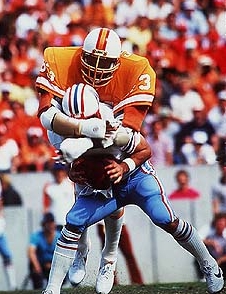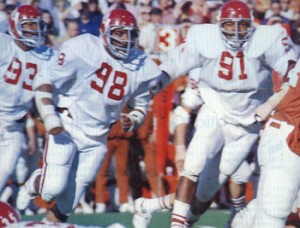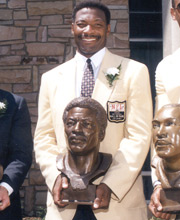Lee Roy Selmon Towered Over Tampa Bay Football
When the Tampa Bay Buccaneers joined the NFL in 1976 with their creamsicle colored uniforms and comical play on the field, they needed someone with credibility to signal to the rest of the league that while they might dress funny and make a lot of bad plays, they were a football team and they were out there trying to create a winner. That someone was the first player ever drafted by the Buccaneers, defensive lineman Lee Roy Selmon.
His death over the weekend following a stroke begs the recollection of the beginning of professional football in Tampa when the Buccaneers went from being a laughing stock to forging a level of respectability by winning two division titles and reaching the playoffs three times in a four year stretch.
For anyone (like me) who grew up on NFL Films, the early years of the Buccaneers can be summed up with two images from the vaults of video past. The first is of whimsical head coach John McKay expressing that he was in favor of his teams’ execution and the second of the 6-foot-3, 256 pound Selmon looking significantly larger than his listed size as he smothers an opposing quarterback.
The best of the three Selmon brothers (Lucious and Dewey were the others), Selmon excelled on and off the field as the University of Oklahoma won consecutive national titles in 1974 and 1975. He won the Outland and Lombardi Trophies and was also an Academic All-American.
After playing for one of the most successful programs in college football, he joined an NFL team that was destined to set a record for futility.
As the first draft pick in the 1976 NFL Draft, Selmon became the first draft pick of the Buccaneers. His brother, Dewey, was selected in the second round and would spend five years in Tampa.
Even though injuries limited Selmon to only eight games as a rookie, it is doubtful his presence would have made a significant difference as the Buccaneers lost all 14 games in their initial season. They tacked on 12 straight losses in their second season to set a new record with 26 straight losses.
However, while the Buccaneers were still not close to respectability, Selmon was starting to make his mark. He recorded a career-high 13 sacks in 1977 and by 1979 was recognized as an All-Pro.
It was in that surprising fourth season of the Buccaneers that the beleaguered team rose from the ashes to a surprising trip to the NFC Championship Game.
The Buccaneers won their first five games and then held on to win the division with a 10-6 record. The decisive 10th win came following a three-game losing streak and was a 3-0 victory over the Kansas City Chiefs during a Florida downpour that left the field nearly unplayable.
However, it proved the perfect statement for the unconventional Buccaneers. Though much of the publicity in 1979 went to young quarterback Doug Williams, it was Selmon and the defense that made Tampa Bay a winner. They led the NFL by allowing only 14.8 points per game while allowing the fewest passing yards in the league.
After surprising the Philadelphia Eagles in their opening playoff game, the Buccaneers appeared poised for an improbable trip to the Super Bowl as Selmon and the defense allowed Los Angeles only nine points in the NFC Championship Game. Unfortunately, the offense couldn’t muster a single point as the dream fell just short.
After a down season in 1980, which happened to be Dewey’s last season with the team, the Buccaneers again won the NFC Central in 1981 and then posted a 5-4 record and made another playoff appearance during the strike-shortened 1982 campaign.
However, that proved to be the high-water mark for the Buccaneers until the late 1990s when another squad built on defense eventually took the team to a Super Bowl title.
Selmon was long-gone by then as injuries halted his stalwart career following the 1984 season. In nine seasons, Selmon made six trips to the Pro Bowl while registering 78.5 sacks in 121 career games.
In 1995 he became the first Tampa Bay Buccaneer player to be inducted into the Pro Football Hall of Fame. While it shouldn’t be too many years before he is joined by Derrick Brooks, Warren Sapp and potentially others from the great teams of the late 1990s and early 2000s, he will likely always remain the lone Hall of Famer from the early years of the Buccaneers.
After his playing days, Selmon served as the Director of Athletics at the University of South Florida and helped them start football and eventually grow the sport into a successful Bowl Championship Subdivision squad. It was fitting that the day after his stroke, the Bulls registered one of the most significant victories in franchise history with a 23-20 win over Notre Dame.
Because he played on a team considered to be a laughing stock by many across the country and had his career shortened to just nine seasons due to injuries, Selmon may never have been considered by most to be one of the all-time greatest players in NFL history, but his presence towered over the Tampa Bay area at a time when football greatness wasn’t part of the lexicon and he will always be remembered as the player that set the table for football glory in Tampa Bay.



Well done
I already have a college degree so I don’t need the credit. I don’t want to pay a ton of money for it, but I do want an actual class with actual assignments. And that’s creative writing as in FICTION. Thanks for your help. A class on the Northside would be great..
One of my all time special quotes appears very fitting here “Success is nothing more than a few simple disciplines, practiced every day; while failure is simply a few errors in judgment, repeated every day. It is the accumulative weight of our disciplines and our judgments that leads us to either fortune or failure.”–Jim Rohn
Wow this is a must read, bookmarking your blog now. Please continue to write, your style is very outside the box.
Excellent blog here! Also your site loads up fast! What sponsor were you using? Am I Allowed To have a affiliate hook up with your host? Only when my website loaded as quickly as yours lol
Wow! This can be one particular of the most helpful blogs We’ve ever arrive across on this subject. Actually Great. I’m also an expert in this topic therefore I can understand your effort.
I’m distinctly surprised to see how positive most of these reviews about windows 7 phone seem to be; but I’m glad to see it.I mean, what applications this Operating system has better than android ???I think the good question is what’s going to be on the mind of early adopters (I am seriously considering being part of that group) is going to be when we might start to see software updates that will fill in some of the gaps that people are already droning on about; and whether or not we’ll be able to update the first generation devices to those new software versions.
Great website. Lots of helpful information here. I¡¦m sending it to a few buddies ans also sharing in delicious. And of course, thanks to your effort!
It is in point of fact a great and helpful piece of info. I’m glad that you shared this helpful tidbit with us. Please stay us informed like this. Thanks for sharing.
I have got one idea for your website. It appears like there are a couple of cascading stylesheet issues when launching a number of web pages in google chrome as well as safari. It is running alright in internet explorer. Perhaps you can double check that.
If you dont mind, where do you host your web site? I am looking for a very good web host and your weblog appears to be quick and up most the time
Hello there! Do you use Twitter? I’d like to follow
you if that would be ok. I’m definitely enjoying your blog and look forward to new posts.
Also visit my web blog It Works Distributors
certainly like your web site however you need to check the spelling on quite a few of your posts.
Many of them are rife with spellijng issues and I find it
very troublesome to tell the reality on
the other hand I will definitely come again again.
My brother recommended I might like this web site. He was entirely right.
This post truly made my day. You cann’t imagine simply how
much time I had spent for this info! Thanks!
Also visit my blog post :: It Works Distributors